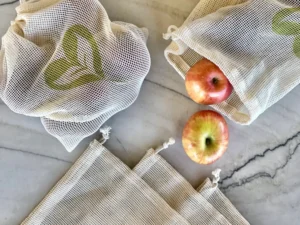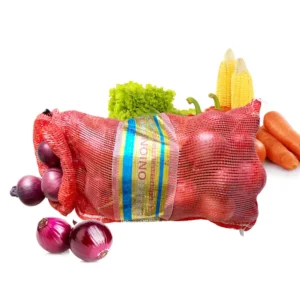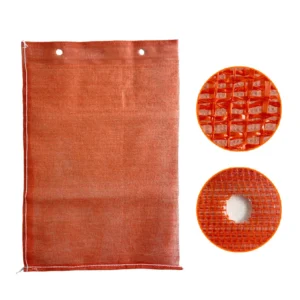To increase the shelf life of your veggies, mesh bags are an absolute solution. Mesh vegetable bags are breathable, lightweight, and easy to store. Mesh bags for vegetables are ideal for storing thick-skinned and root veggies like onions, garlic, and potatoes.
Nylon mesh bags for vegetables are strong, flexible, lightweight, and cost-effective. They are 100% recyclable and reusable and thus are eco-friendly too.
These bags are available in variable sizes, and colors, and are also customizable. Let’s explore more about the various types of mesh bags for fruits and vegetables.
Keep rolling!
How Many Types of Mesh Fruit and Vegetable Bags Are There?
1. Basic Type
When it comes to vegetable bags, the most basic type is made of fine mesh material that is suitable for most vegetables. This type of bag is great for minimizing the use of single-use plastics and paper bags.
Storing vegetables in mesh bags makes transporting fruits and vegetables easier and damage-free. These bags are also versatile and can be used for a wide variety of produce, including onions, potatoes, lettuce, and carrots.
2. Types Based on Vegetable Types
If you’re looking for bags specifically designed to accommodate heavier or fragile vegetables, here are a few options:
Reinforced Mesh Bags
These bags are constructed with stronger and more durable materials. Such as thickened mesh or reinforced stitching. As a result, they can hold heavier vegetables without tearing or breaking. Look for bags that explicitly mention reinforcement or heavy-duty features.
Fine Mesh Bags
Fine mesh bags have smaller openings compared to regular mesh bags. As a result, they are suitable for delicate or small vegetables, preventing them from slipping through or getting damaged. Fine mesh bags are ideal for holding items like cherry tomatoes, berries, or herbs.
Padded Mesh Bags
For extremely fragile vegetables, padded mesh bags provide extra cushioning and protection. These bags usually feature a soft padding material, such as foam or cotton. This material is sewn into the mesh fabric to safeguard delicate produce from bruising or impacts.
3. Special Types
Drawstring Bags
Drawstring mesh bags are the most popular type of reusable mesh vegetable bags. The drawstring closure lets one open and close the bag, making it easily convenient. These bags are also eco-friendly because of their reusability.
However, its biggest disadvantage is that it could be better for storing vegetables that require a humid environment. In addition, these vegetable bags are often designed to be compact and lightweight. This may restrict their capacity for carrying larger or bulkier vegetables.
Refrigerated Bags
These are specifically designed mesh bags for storing vegetables in the refrigerator. In addition, these bags come with an additional insulation layer, which helps to keep the vegetables fresh for a more extended period. In addition, the bags come with a zipper closure, which helps to keep the vegetables secured.
These bags can be quite expensive compared to drawstring mesh bags. Also, they may need to be more versatile and can only be used to store vegetables in the refrigerator.
Multi-Functional Bags
Multi-functional are designed to cater to a variety of needs. They are made with various compartments, each designed with a different function.
For instance, some of these bags come with a separate compartment for dry vegetables. While others have a section for refrigerated vegetables. The multi-functional mesh bags are versatile and can store different types of produce.
They can sometimes be challenging to clean, primarily if the bags have several compartments.
Types Based on Material
Cotton Mesh Bags

Cotton mesh bags for vegetables are eco-friendly because they are made of natural materials. These are an added plus for people looking for sustainable options. These bags are also free from harmful chemicals.
However, they are less durable than vegetable bags since they might tear or stretch over time. In addition, cotton mesh bags are not machine washable, so they need to be washed by hand, and they usually have a lower weight carrying capacity.
Screen Bag
Mesh vegetable bags made of screen material are highly breathable, allowing vegetables to stay fresh longer. They are also reusable mesh bags for vegetables. Unlike plastic bags, they allow optimal storage with minimal moisture buildup.
On the other hand, screen bags are less durable than plastic bags and may tear over time. Additionally, small vegetables may easily slip through the holes in the mesh. Potentially leading to frustration for the consumer.
Polyester Mesh Bags

Polyester mesh bags are more durable than cotton mesh bags since they do not stretch easily. In addition, they can be machine washable, which makes maintenance a lot easier.
The disadvantage of polyester mesh bags is that they are not eco-friendly as they are made from synthetic materials. However, they have a higher weight-carrying capacity than cotton mesh bags. Thus, making them great for carrying heavy vegetables.
Nylon Mesh Bags
Nylon mesh bags are similar to polyester mesh bags in durability and machine washability. In addition, they have a higher weight carrying capacity than cotton bags, which makes them ideal mesh vegetable shopping bags.
However, they could be more environmentally friendly. Nylon mesh bags are also more expensive than cotton and polyester mesh bags, primarily because of their material.
Silicone Mesh bags
Along with nylon, these are the ideal mesh bags for boiling vegetables because of their heat resistance (~400℃). In addition, the food-grade silicone material is non-toxic and safe for food contact, ensuring the freshness and integrity of your produce.
Being the most used mesh vegetable storage bags, they allow for proper airflow, preventing moisture buildup, and extending fruits and vegetables’ shelf life. Silicone mesh bags are also durable, tear-resistant, and reusable.
How to Use Mesh Vegetable Bags?

1. Select the Right Bag
Choose a mesh bag suitable for your specific needs, like the vegetable mesh bag roll for multiple uses or mesh vegetable bags wholesale if you run a business.
Consider factors such as size, mesh opening, and durability based on the type and quantity of vegetables you plan to store or transport.
2. Load the Bag
Place the vegetables into the mesh bag, ensuring you don’t overcrowd it. Leave enough space for air circulation to prevent premature spoilage.
3. Secure the Bag
Depending on the type of mesh bag you have, use the provided closure mechanism, such as a drawstring, toggle, or zipper, to seal the bag securely. This step prevents the vegetables from falling out or getting damaged during transportation or storage.
4. Store or Transport
Once your mesh bag is securely closed, you can store it in the refrigerator, pantry, or any suitable storage area. Alternatively, if you’re using the bag to transport vegetables, ensure it is placed securely to prevent shifting or crushing.
5. Cleaning and Reusing
For recycling mesh vegetable bags, empty any remaining vegetables and rinse the bag with water to remove any residue. Depending on the material and manufacturer’s instructions, you can hand wash or machine wash the bag. Then, dry the bag completely for reuse.
Conclusion
Mesh vegetable bags are versatile and practical for storing and transporting produce. They provide breathability, a lightweight design, and easy storage. Different types cater to specific needs, from fine mesh for delicate produce to heat-resistant silicone bags. You can maintain freshness and organization by selecting the right bag, cleaning vegetables, and securely sealing it.
